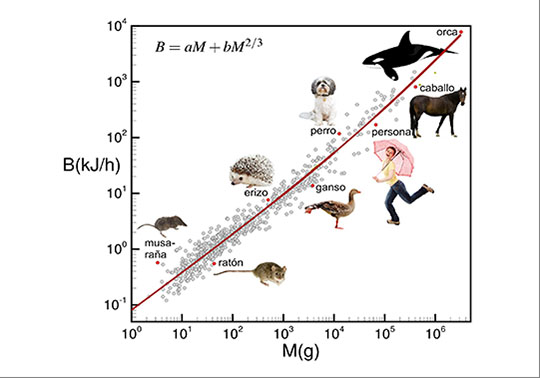Users
Social media
- More details here...
- Address
Parc Científic de la Universitat de València C/
Catedrático Agustín Escardino, 9
46980 Paterna (Valencia) Spain - Email:
iu.i2sysbio@uv.es - Phone:
(+34) 963544810
- Address
Links
Researchers from the University discover why the basal metabolism of living beings varies with their mass

Educaction
Researchers from the University discover why the basal metabolism of living beings varies with their mass

A multidisciplinary team of researchers from the University of Valencia, the Polytechnic University of Madrid and the Queen Mary University of London has managed to solve a puzzle that has baffled biologists for more than a century: how and why the basal metabolism of an organism varies with its mass. Basal metabolism is the minimum energy that an organism consumes to stay alive. The work is published in the digital Scientific Reports, Nature's open access.
An adult human at complete rest and at an ambient temperature of 20º C consumes approximately one calorie per kilo per hour. However, an elephant spends half a calorie per kilo of mass in that same time and a mouse spends a whopping 70 calories per kilo. What is the cause of this difference?
One of the first to realize the phenomenon was the German physiologist Max Rubner when studying in 1883 the basal metabolism of dogs of different sizes. Rubner proposed that the cause of the phenomenon was heat lost through the skin. As the surface of the skin varies with the square of the size of the animal, while its volume varies with the cube, this would imply that basal metabolism B varies proportionally to the mass raised to 2/3, M2/3. However, in 1932, measurements that his namesake Max Kleiber, a Swiss biologist, made in mammals over a larger range of masses, including oxen and rats, seemed to indicate that metabolism actually varied according to M3/4, a relationship that we know today as Kleiber's law.
The search for an explanation for this exponent opened an intense debate for decades, which seemed to conclude in 1997 with the model. fractal by physicist Geoffrey West and collaborators. This model justified the exponent due to the fractal form of resource distribution networks in organisms, such as the circulatory or respiratory system. Measuring the basal rate in organisms is a delicate and laborious experimental task. As metabolic measurements were increased in more animals, the fractal model began to show more and more discrepancies. Thus, in some animal groups such as small birds or insects, the exponent 3/4 does not fit. And even in mammals, for which Kleiber's law was conceived, the data show a notable divergence from the theoretical law.
Now the authors of an article recently published in Scientific Reports, Fernando J. Ballesteros and Vicent J. Martínez (Astronomical Observatory of the University of València), Bartolo Luque (E.T.S.I. Aeronáuticos of the Polytechnic University of Madrid), Lucas Lacasa (School of Mathematical Sciences, Queen Mary University of London), Enric Valor (Dep. Thermodynamics of the University of Valencia) and Andrés Moya (Institute of Integrative and Systems Biology-UV/CSIC), have found the piece that completes the puzzle, based on a theoretical model of Astrophysics. "During the writing of the book 'Fractals and chaos', in which we talked about Kleiber's law, we realized that the fractal model of West and collaborators did not fit. The thermal explanation seemed more natural, but we had to take into account the energetic part that is not dissipated as heat," comments Fernando Ballesteros. "Vicent and I introduced this into the thermal model and saw that the data fit perfectly with our theory. Andrés immediately realized that our model was a trade off, an evolutionary exchange, and together we perfected it. Enric solidified the thermal model after the trade off, and Bartolo and Lucas extended the work to other living beings in addition to mammals, confirming its predictive power," he concludes.
The Scientists propose as a solution a compromise between passive heat dissipation and the minimum energy expenditure for cellular maintenance. Not all the energy that an organism consumes is transformed into heat, part is used for cell division, to synthesize proteins..., that is, to make the organism function and maintain. If all the energy consumed was transformed into heat, in effect consumption would respond to an exponent 2/3, but then we would not be talking about an organism but rather a stove. On the other hand, if all energy were consumed efficiently, consumption would be directly proportional to the number of cells, that is, to the mass M, but some is inevitably lost as heat. Real organisms maintain a compromise between these two extremes. The weighted sum of both components, one proportional to the mass M and the other to M2/3; that is, B = aM + bM2/3, explains the curvature in the basal metabolism of the mammalian data and the different relationships found in different animal groups, but also the metabolic differences between desert and polar animals, or even the metabolism of plants.
On the thermodynamic origin of metabolic scaling. Fernando J. Ballesteros, Vicent J. Martínez, Bartolo Luque, Lucas Lacasa, Enric Valor & Andrés Moya
Scientific Reports, 17-30960 (2018)
List of links:


